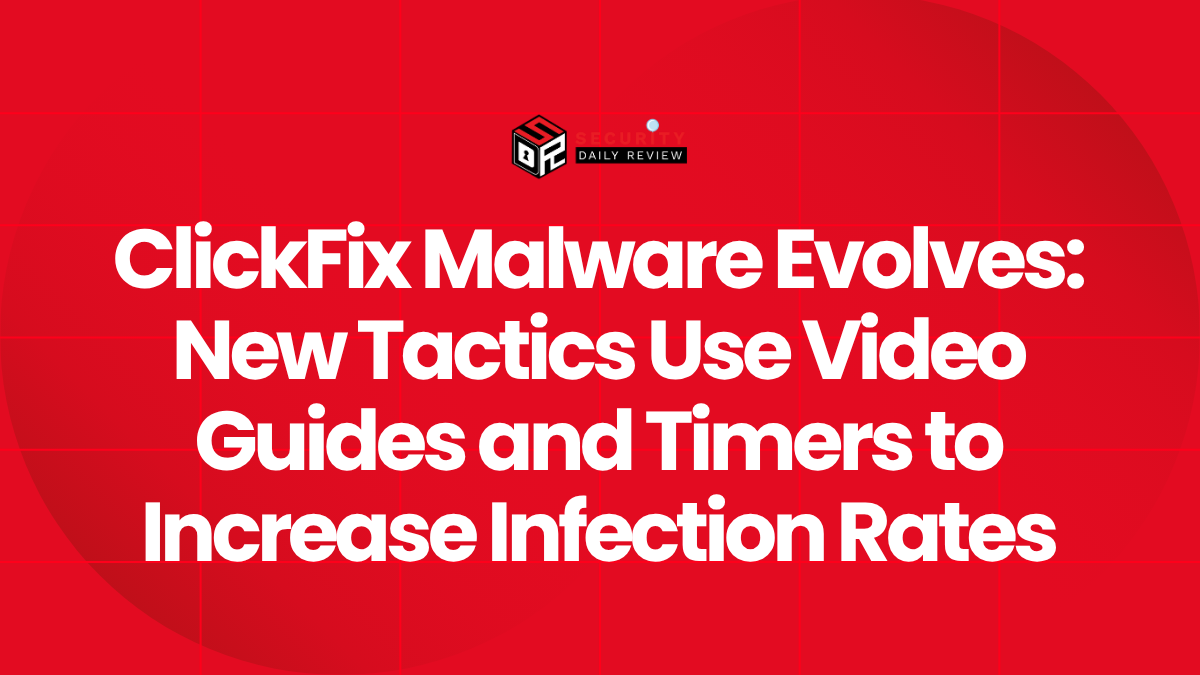Cybercriminals behind the ClickFix malware are pushing the boundaries of social engineering. This recently observed threat campaign escalates user manipulation by adding a suite of disruptive psychological and technical tricks, including fake video guides, countdown timers, and automated operating system (OS) detection. These enhancements are aimed at coercing victims into compromising their own systems manually.
Threat Actors Now Rely on Social Engineering Over Malware Delivery
ClickFix does not depend on exploiting remote code execution flaws or prebuilt payloads. Instead, it requires user interaction in an increasingly deceptive manner. Remote attackers trick victims into manually executing commands that effectively “self-infect” their systems.
This campaign highlights a trend toward highly polished phishing techniques using web-based delivery mechanisms and dynamic content custom-tailored for the target’s environment.
Malware Delivered Through Deceptive Websites
Victims are typically lured through phishing emails that direct them to bogus technical support sites or fake login pages. These websites pose as legitimate services or support portals and instruct the user to run seemingly routine diagnostic or setup commands.
New social engineering features include:
- Step-by-step video walk-throughs : These guide victims interactively through the infection process, helping create a misleading impression that the source is trustworthy.
- Countdown timers : Visual countdowns create psychological pressure, suggesting urgency, and prompting hasty decision-making.
- Automated OS detection : The malicious site tailors instructions depending on whether the visitor uses Windows, macOS, or Linux, increasing the likelihood that commands will execute without errors.
By combining these tactics, the threat actors increase the success rate of their phishing operations while reducing dependency on traditional exploit delivery methods, making their campaign attractive to a broader pool of adversaries with limited technical skill.
Technical Execution Adapts Dynamically to Victim Systems
Unlike conventional malware that leverages precompiled payloads or exploits specific vulnerabilities, ClickFix’s operational model is focused on platform-aware, command-line driven infection.
The attack chain typically follows this pattern:
- The victim receives or encounters a socially engineered message, usually via email or messaging platforms.
- A link leads them to a fake website embedded with convincing UI elements and dynamic scripts.
- The site detects the user’s operating system and generates context-specific terminal commands.
- A video guide then walks the victim through the copy-paste or execution of these commands.
- Once run, the commands download and execute the actual malicious payload.
Multi-OS Support Raises Risks Across Environments
By accommodating Windows, macOS, and Linux, the ClickFix campaign poses a broader threat than previous attacks limited to one platform. The malware authors exploit the nuances of each system, increasing the likelihood that targets will comply based on familiar OS-specific instructions.
For example:
- Windows users may be persuaded to use PowerShell scripts.
- Linux and macOS users are typically instructed to run Bash or cURL commands in a terminal window.
- All variants attempt to disable endpoint protections and gain persistent remote access.
This cross-platform capability makes detection and prevention more complex for defenders, especially in environments where Bring Your Own Device (BYOD) policies introduce further heterogeneity in endpoints.
Implications for Enterprise Defenses and User Training
Enterprises must recognize this evolution in social engineering as a serious threat. Unlike zero-day exploits or mass malware campaigns, ClickFix relies on victim cooperation—a tactic that can bypass traditional security measures.
Recommendations for Defenders
To address this unique attack vector effectively, security teams should focus on a blend of technical controls and awareness training:
- Web content filtering to block access to known malicious domains.
- Email screening with phishing detection capabilities to intercept lures.
- Endpoint behavioral monitoring to detect anomalous user activity, such as unauthorized terminal usage.
- User training programs that emphasize the dangers of running unsolicited commands, even if provided by what seems like a legitimate support site.
Additionally, implementing browser isolation and securing unmanaged endpoints with policy controls can help reduce exposure, particularly in environments where employees work remotely or regularly engage with web-based services.
A New Chapter in Malware Evolution
The ClickFix campaign underlines how malware delivery does not always require complex exploits. Instead, modern attacks increasingly rely on evolving social engineering techniques that trick users into executing the final payload themselves.
By integrating high-pressure interfaces, personalized commands, and educational deception through video, ClickFix exemplifies the future of malware campaigns driven more by psychological manipulation than brute-force compromise. The fusion of multimedia, dynamic scripting, and cross-platform compatibility represents a worrying trend for defenders and illustrates the continual adaptation of cybercriminal strategies in the face of tightening technical controls.









